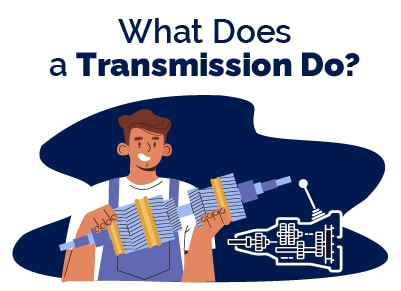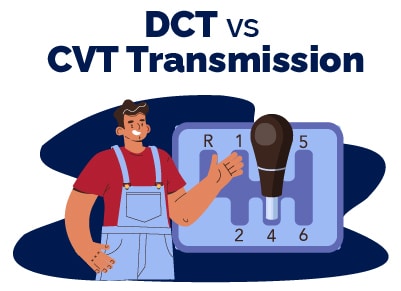Dual-Clutch Transmissions Explained: A Detailed Guide
September 14, 2021


I am a serial entrepreneur and a consumer advocate. When I’m not helping car buyers, I love working on ventures that have a positive impact.
I run a cause marketing agency and serve on the board of Vayu Global Health where we are disrupting the medical industry and preventing the needless deaths of mothers and babies during childbirth.
While researching for your next car, one important decision is, what type of transmission should I get?
It may start with a choice between automatic or manual transmission, but there's more to it than just that.
One that you may not see often is a dual-clutch transmission or DCT. So let's dive deeper into what it is and how it works.
Table of Contents
- What Does a Car Transmission Do?
- What is DCT or Dual-Clutch Transmission? How Does It Work?
- What Does Clutch Mean?
- Dual-Clutch Transmission Pros
- Dual-Clutch Transmission Cons
- Dual-Clutch Transmission Problems
- DCT vs CVT Transmission
- How Long Do Dual-Clutch Transmissions Last?
- Are Dual-Clutch Transmissions Reliable?
- Car Research & Comparisons
- Frequently Asked Questions
What Does a Car Transmission Do?
 A car's transmission helps the driver move the car. It changes gears so that you can go at different speeds. Most of today's passenger cars have 5 or 6 gears, but more performance-based vehicles have up to 8 speeds.
A car's transmission helps the driver move the car. It changes gears so that you can go at different speeds. Most of today's passenger cars have 5 or 6 gears, but more performance-based vehicles have up to 8 speeds.
Transmissions can be of two types: automatic and manual. Manual transmissions need you to operate the gears yourself, while an automatic transmission allows the car to do it for you. Manual transmissions are more common in older cars.
What is DCT or Dual-Clutch Transmission? How Does It Work?
 Dual-clutch transmissions (DCT) are a type of automatic transmission that works unconventionally. It's actually two manual transmissions with extra gears connecting them, so one clutch controls the odd gears, and the other clutch controls the even ones. The gearbox manages to shift up or down without losing time because you have two clutches. You'll find DCTs primarily in performance and sports cars.
Dual-clutch transmissions (DCT) are a type of automatic transmission that works unconventionally. It's actually two manual transmissions with extra gears connecting them, so one clutch controls the odd gears, and the other clutch controls the even ones. The gearbox manages to shift up or down without losing time because you have two clutches. You'll find DCTs primarily in performance and sports cars.
This might sound complicated, but it's actually more efficient than using a standard torque converter auto because it takes advantage of both engine power and instantaneous torque.
What Does Clutch Mean?
 To explain further, you should know what a clutch is. A clutch is a band or mechanism of steel plates that connect the engine to the transmission when it needs to be activated. It's activated by pressing on the pedal which engages it and makes it work with your car.
To explain further, you should know what a clutch is. A clutch is a band or mechanism of steel plates that connect the engine to the transmission when it needs to be activated. It's activated by pressing on the pedal which engages it and makes it work with your car.
There are different types of clutches depending on what they're made of, but the most common type is a disc-shaped item made of steel. This clutch can be engaged or disengaged by pressing on the pedal. When it's disengaged, you're free to change gears using the manual transmission without grinding them.
When you have a car with DCT Transmission, then you won't need to change gears manually. The whole process will be automated, and you can enjoy driving your car without having to worry about shifting gears at all.
What is Double Clutch?
Double clutching is not seen often these days and is mostly used in commercial or specialty vehicles. Double-clutching is a method of shifting gears where the driver uses the clutch pedal twice during a single gear shift. Cars without synchronizers in the transmission need the double-clutch method.
Dual-clutch and double-clutch sound similar, but they are fairly different. A dual-clutch is a type of system, while double-clutch is a certain way for the driver to switch gears.
Dual-Clutch Transmission Pros
 Speed. They're faster than manuals because the driver just needs to focus on getting from one place to another without worrying about how to best shift.
Speed. They're faster than manuals because the driver just needs to focus on getting from one place to another without worrying about how to best shift.- Transmission Strain. There's less strain on the transmission and mechanical parts because of the high torque and power that the engine generates when it's combined with a dual-clutch transmission.
- Control. The DCT gives you better control over your car by making every shift smooth and easy. It also makes for a more enjoyable drive, especially in some sports cars.
Dual-Clutch Transmission Cons
 Price. A dual-clutch transmission is more expensive than a manual, but some people are willing to pay the extra money because of all the benefits it offers. You should keep in mind that every car has its own unique make and model specs, so there isn't one price for them all.
Price. A dual-clutch transmission is more expensive than a manual, but some people are willing to pay the extra money because of all the benefits it offers. You should keep in mind that every car has its own unique make and model specs, so there isn't one price for them all.- Complexity. Some people are concerned that this type of transmission is complicated, but it actually isn't if you experiment with different techniques to see what works best for your vehicle.
- Weight. The dual-clutch transmission is lighter than a regular gearbox, so you might not want to use it in heavy vehicles like trucks. Also, the car will need to be in neutral to switch gears because the two clutches need to be deactivated at this time.
Dual-Clutch Transmission Problems
A dual-clutch transmission has a few problems as well. Here are some of them:
- The DCT is difficult to fix when it breaks down, so you'll need to hire a professional who knows how to work on them if anything goes wrong.
- You can't buy a used dual-clutch transmission and install it in your car. They're built to work with a specific car only, so you'll have to buy a new one if yours breaks down and can't be fixed.
DCT vs CVT Transmission
 Some people compare dual-clutch transmission to continuously variable transmissions (CVT). A CVT is usually used in small and medium-size cars because they're easier and cheaper to build. They also function like an automatic because you can't change gears manually – the computer does it for you.
Some people compare dual-clutch transmission to continuously variable transmissions (CVT). A CVT is usually used in small and medium-size cars because they're easier and cheaper to build. They also function like an automatic because you can't change gears manually – the computer does it for you.
The main difference between a DCT and a CVT is that the first one has two separate clutches, so you can easily change gears without the help of computers. The second type works with belts and pulleys to adjust the transmission ratio automatically, so there are no mechanical parts inside it.
How Long Do Dual-Clutch Transmissions Last?
 Dual-clutch transmissions are generally very reliable, but they can fail if you don't maintain or fix them. If the gearbox is not well-built then it will be more likely to break down, so you have to consider buying a new one before it goes bad.
Dual-clutch transmissions are generally very reliable, but they can fail if you don't maintain or fix them. If the gearbox is not well-built then it will be more likely to break down, so you have to consider buying a new one before it goes bad.
The DCT usually lasts around 10 years because the gears inside the mechanism are made from durable materials that don't wear down quickly. However, you'll need to have it maintained regularly because this is still a complex technology that needs maintenance now and then.
Are Dual-Clutch Transmissions Reliable?
Standard automatic transmissions are much more reliable than dual-clutch transmissions because they use fewer components. A DCT uses two gearboxes (one for even gears and one for odd gears) and several sensors, so it's more complex than automatic transmissions.
Frequently Asked Questions
Which is better, CVT or DCT?
This is, of course, a matter of opinion. If you're looking for efficiency and a smoother ride, then the CVT is the way to go. However, if you want to feel the gears changing and for quicker acceleration, then consider a DCT.
How long do DCTs last?
Most DCTs last around 100,000-200,000 miles before they start to slip or have a problem.
Is DCT manual or automatic?
DCTs are neither fully manual nor automatic. This is a source of confusion for many people, as it appears to be a traditional transmission – but because there is no clutch pedal and the driver has no control over gears, these cars should really be considered semi-automatic.
What are the advantages of DCT?
The major advantage of DCT is two-fold. The first is improved fuel economy, as the car can change gears much faster than a standard transmission could ever hope to do. The second is that it enables smoother acceleration, especially from lower speeds.
What are the disadvantages of DCT?
One of the main disadvantages is that under heavy acceleration, there's sometimes a split-second hesitation as it changes gears. This can be more pronounced when changing between 3rd and 4th gear under heavy acceleration. Another common criticism is that DCTs are slow to downshift; this seems to vary from car to car, though.
What car models have DCT transmission?
The latest BMW 7-series is available with DCT. Other cars that come with the option of a DCT (but not exclusively) are Audi's RS3, RS4, RS5 and A5, Mercedes' AMG 63s and C63s, Porsche's 911 Turbo, 918 Spyder and Carrera S, Cayman S and Boxster S, and Jaguar's XFR-S.
Posted in Car Buying Tips |







